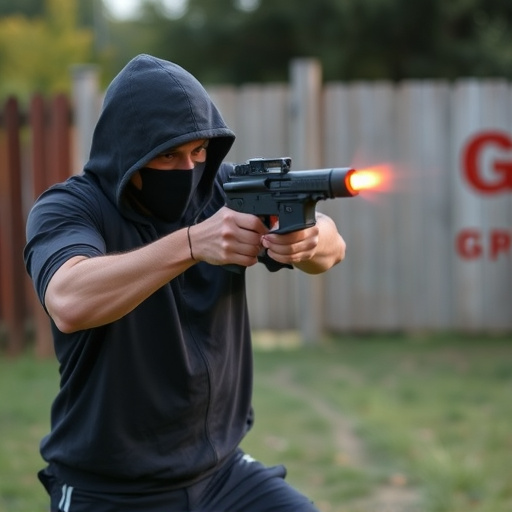Unveiling Stun Gun Effectiveness: Current Spread Pattern Analysis
Understanding electrical current spread patterns is vital in developing best-rated stun guns for eff…….
Understanding electrical current spread patterns is vital in developing best-rated stun guns for effective self-defense. By analyzing how charged particles flow, designers can optimize tools that deliver precise and controlled electric shocks, temporarily disabling attackers without severe harm. Key factors include voltage, resistance matching, electrode design, and strategic placement. Advanced simulation tools like finite element analysis (FEA) predict current flow, ensuring optimal performance and safety. Rigorous laboratory testing further refines designs, leading to more effective and user-friendly best-rated stun guns that meet stringent safety standards for reliable self-defense.
Electrical current spread patterns are crucial in understanding how energy flows through various materials, especially in the context of self-defense tools like stun guns. This article delves into the intricate behavior of electrical current, highlighting its interaction with resistance and its practical applications. We explore the role of best-rated stun guns as case studies, analyzing their design features that significantly influence current distribution. Additionally, testing methods and future research directions are discussed to enhance our understanding of this vital topic.
- Understanding Electrical Current and Its Behavior
- The Role of Resistance in Current Spread
- Best-Rated Stun Guns: A Case Study for Self-Defense Applications
- Analyzing Stun Gun Design: Key Features Influencing Current Distribution
- Testing and Evaluation Methods for Current Spread Patterns
- Practical Implications and Future Research Directions
Understanding Electrical Current and Its Behavior

Electrical current, a fundamental concept in physics and engineering, represents the flow of charged particles, typically electrons, through a conductor. Understanding how this current behaves is crucial, especially when considering its application in self-defense tools like best-rated stun guns. These devices utilize electric current to temporarily disable or stun an assailant, making it vital to grasp the principles governing its distribution and impact.
The spread pattern of electrical current depends on various factors such as the conductor’s material, size, and shape. In the context of stun guns, designers must account for these patterns to ensure consistent and effective delivery of electric shock. By studying how current flows through different materials and shapes, researchers can optimize the design of stun guns, making them more efficient and reliable tools for personal protection.
The Role of Resistance in Current Spread

In electrical current spread pattern analysis, resistance plays a pivotal role in determining how and where current flows through a medium. When considering self-defense tools like best-rated stun guns, understanding this dynamic becomes crucial. Resistance acts as a barrier that slows down or obstructs the movement of electric charge. In the context of a stun gun, the target’s body resistance influences the current’s distribution and intensity at the point of contact. Higher resistance results in more concentrated current flow, enhancing the stun effect. Conversely, lower resistance allows for a more diffuse spread of current, potentially reducing the impact but increasing the overall energy dissipation.
The interaction between current and resistance is governed by Ohm’s Law (I = V/R), where I represents current, V is voltage, and R is resistance. This fundamental relationship underscores why stun guns are designed to generate high voltages in order to overcome body resistance and deliver a powerful electrical shock. By manipulating the voltage and ensuring optimal resistance matching, manufacturers aim to create best-rated stun guns that provide reliable self-defense capabilities with precise current spread patterns.
Best-Rated Stun Guns: A Case Study for Self-Defense Applications

In the realm of personal safety and self-defense, best-rated stun guns have emerged as a reliable tool for individuals seeking to protect themselves in various situations. These devices operate by delivering an electric shock, temporarily incapacitating the attacker and providing precious time for escape or assistance. Analysis of their spread pattern reveals several key aspects crucial for effective deployment.
Best-rated stun guns are designed with optimal power output and precision in mind, ensuring a controlled release of electricity that disrupts muscle function without causing severe harm. The analysis of their spread patterns highlights the importance of range, frequency, and intensity. Models with longer ranges allow users to maintain distance from potential threats, while high-frequency discharges contribute to faster knockdown times. Additionally, understanding the anatomical targets within the impact zone is vital; focusing on nerve centers and muscle groups can significantly enhance the stun gun’s effectiveness in neutralizing attackers without causing permanent injury.
Analyzing Stun Gun Design: Key Features Influencing Current Distribution

Stun gun design plays a pivotal role in determining how electrical current spreads and affects the target. Key features that significantly influence current distribution include the type of electrodes used, their placement, and overall shape of the device. Best-rated stun guns for self-defense often incorporate advanced electrode designs to maximize shock effectiveness while minimizing risks to the user.
For instance, some models employ multiple, strategically positioned electrodes that facilitate a more uniform current flow, ensuring a powerful and precise shock. The design might also consider factors like current intensity and duration, which are crucial in neutralizing an assailant quickly and safely. These considerations are essential for users seeking reliable self-defense solutions among the best-rated stun guns available in the market.
Testing and Evaluation Methods for Current Spread Patterns

In the realm of electrical safety and defense, understanding current spread patterns is paramount, especially when evaluating best-rated stun guns for self-defense applications. Testing and evaluation methods play a crucial role in gauging how effectively these devices disperse electrical energy to neutralize threats. Researchers employ advanced simulation techniques, such as finite element analysis (FEA), to model the behavior of currents within stun gun components. This computational approach allows for precise prediction of current flow patterns, ensuring optimal performance and minimizing risks associated with excessive current density.
Moreover, experimental testing involves subjecting simulated scenarios to real-world conditions. Laboratory settings enable controlled comparisons between different stun gun designs, assessing their ability to control and contain electrical currents. Such evaluations are essential in identifying potential hazards and refining the technology for enhanced safety features, particularly when considering the impact on users and bystanders. These rigorous testing methods contribute to the development of more effective and user-friendly best-rated stun guns, ensuring they meet stringent safety standards while providing reliable self-defense capabilities.
Practical Implications and Future Research Directions

In practical terms, understanding the spread pattern of electrical current can significantly enhance safety measures and self-defense strategies. The knowledge gained from such analysis is pivotal for designing efficient protective gear, especially when it comes to best-rated stun guns for self-defense. By studying how electricity flows through different materials and bodies, engineers and designers can create devices that deliver precise and effective jolts while minimizing unintended harm. This includes optimizing the placement of electrodes and understanding the body’s response to electrical shocks, ensuring user safety and the weapon’s effectiveness.
Looking ahead, future research in this domain could explore innovative applications beyond traditional stun guns. The insights derived from spread pattern analysis may open doors to new technologies, such as advanced non-lethal weapons or even medical devices that utilize electric currents for targeted treatments. Additionally, investigating the interaction of electrical current with different environments and materials can lead to improved safety protocols in high-risk industries, further expanding the practical implications of this field of study.
Electrical current spread pattern analysis plays a crucial role in understanding how stun guns deliver their shock, particularly in self-defense applications. By examining the behavior of electrical current, especially its distribution influenced by resistance, we can better appreciate the design and effectiveness of best-rated stun guns. Further research in this area could lead to advancements in personal safety technology, enhancing the overall effectiveness and safety of these devices. In terms of practical implications, the insights gained from analyzing current spread patterns can guide future innovations in stun gun design, ensuring they remain reliable tools for self-defense.


